Featured Application
The potential application of the research results presented in this paper relates to artificially intelligent (deep learning-based) techniques for the design and production of 3D printed chainmails with personalized mechanical properties, including for medical exoskeletons (wearable robots).
Abstract
The aim of this paper is to refine a scientific solution to the problem of automated or semi-automated efficient and practical design of 3D printed chainmails of exoskeletons with pre-programmed properties (variable stiffness/flexibility depending on direction) reflecting individual user needs, including different types and degrees of deficit. We demonstrate this with the example of using chainmail in a hand exoskeleton, where 3D printed chainmail components can be arranged in a single-layer structure with adjustable one- or two-way bending modulus. The novelty of the proposed approach consists in combining the use of real data from research on the exoskeleton of the hand, new methods of their analysis using deep neural networks, with a clear and scalable design of a 3D printed fabric product that can be personalized (mechanical parameters such as stiffness and bend angles in various directions) to the needs and goals of therapy in a particular patient. So far, this approach is unique, having no equivalent in the literature. This paves the way for a wider implementation of adaptive chainmails based on machine learning, more efficient for more complex chainmail designs.
1. Introduction
The long-term changes in the economy in the first, second and third industrial revolutions brought not only changes in technology or in the proportions of employment in agriculture, industry and services in developed economies, but also in industrial logic. The fourth industrial revolution (Industry 4.0), observed in the third decade of the 21st century, is based on communication, the use of networks, the Internet of Things and cyber physical systems. This represents a departure from the mass production of identical products manufactured on an assembly line. Reconfigurable manufacturing lines allow the mass customisation of products, i.e., the large-scale production of individualised products to order at even lower costs than before [1]. Such changes require not only the availability of technology, a longer time for introduction, social acceptance of their introduction and an appropriate business model. Industry starts to function almost as a service: technology is changing not only the manufacturing sector, but also services, in much the same way that cloud technology has changed the way IT (information technology) services are delivered (Infrastructure as a Service-IaaS, Platform as a Service-IaaS, Software as a Service-SaaS). The proliferation of digital industrial technology allows for more efficient collaboration in the operator-machine and machine-to-machine relationships. Smart technologies (big data, artificial intelligent analysis, cloud computing, horizontal and vertical integration, augmented reality, internet of things, 3D printing, autonomous robots, simulation and digital twins and cyber security) are not only changing the face of industrial production, but also of transport or eHealth, giving them new possibilities, including the autonomous operation of entire processes. Robots will become increasingly intelligent, including within the framework of the circular economy and human–robot collaboration [2]. The benefits of Industry 4.0 are: flexibility (scalability, modularity, management of production process variants, open production standards), speed (small batch, individualized production with optimal stocks and costs), efficiency and competitiveness (low costs with high innovation and no plant migration). Hence, smart factories, i.e., a combination of smart production, smart manufacturing services (including technical control throughout the production cycle and prediction of wear and tear and damage) and smart green machines, will become increasingly common. Hence the search for new design, manufacturing and business models (e.g., unification) that constitute a compromise between the need to reduce costs and the feasibility of a given production process. Markets open to products with specific parameters along with a quick response to changes in demand. The customer becomes an active participant in product design—they create their own product configuration from pre-designed (by the manufacturer) modules, and then such a product is manufactured. Reconfigurable production systems, ensuring efficiency and functionality tailored to the needs of customers and the dynamics of their changes, can even choose the place of implementation of the next stages of processing, taking into account the location of the target customer (it does not have to be the customer). This personalization covers the entire monitored product life cycle [3].
A mechatronic exoskeleton (wearable robot) is an external skeleton worn on the body or parts of the human body to support the human’s movements passively (using elastic elements: rubbers or springs) or actively (using actuators). The origins of exoskeletons are quite long, deriving from mechanical active orthoses, but the first functioning exoskeletons were only constructed at the turn of the 20th century thanks to advances in computer science and robotics. Despite advances in exoskeleton design, the greatest challenge remained the five-finger exoskeleton that supports the movements of the fingers of the hand. The chainmail presented in this article is part of such an exoskeleton, which we are developing as part of a separate project. The use of deep learning in the construction and fitting of exoskeletons, including personalized ones, is still rare [4,5]. We also do not know the neurological/cognitive consequences of all the changes made [6,7]. A review of the five most important bibliographic databases showed that in 2018–2022, only 17 scientific articles on the use of deep learning (DL) in the field of exoskeletons were published, of which only 2 concerned 3D printed exoskeletons. In this way, we identified the research gap in which we will locate this research. The research gap is the lack of a DL-based model that accurately and flexibly reflects the 3D printed fabric design process for personalized and precision medicine. Indirectly, such a gap is also the lack of framework and guidelines for further research on advanced models that are technically feasible, fast and cheap to operate, and clinically useful in the area of Industry 4.0 and eHealth. This especially applies to personalized medical mass devices that meet the requirements of MDR and ISO 13485. An effective solution in this area can bring significant scientific, clinical, social and economic benefits [8,9,10].
The situation is improved by the fact that in 2018–2022, 57 scientific articles on the use of DL in 3D printing were published, the experience of which can be partially used. As part of the literature and retrospective analysis, we reviewed the methods of classical statistical analysis supported by computational analysis (artificial intelligence (AI), mainly machine learning (ML)). We analyzed the known and researched relationships that will be selected by us and used to teach deep artificial neural networks [11].
The innovation of the approach we propose in this paper is the combination of using real data from hand exoskeleton research, new methods of their analysis using deep neural networks, with a clear and scalable design of a 3D printed fabric product that can be personalized (mechanical parameters such as stiffness and bend angles in various directions) to the needs and goals of therapy in a particular patient. So far, this approach is very rare [12].
The research is a continuation of previous work on the hand exoskeleton and its components [13,14,15,16]. Three-dimensional printed chainmails developed since 2013 are classified as materials for four-dimensional printing (4D, i.e., with properties that change over time). The chainmail technology comes from an ancient armourer tradition. It is estimated that up to several thousand types of weave have been developed to date, both for military and decorative applications. The 3D printing technology allowed to go beyond the current limitations of the methods of braiding and the properties of materials (metals). This makes chainmails and the products and services based on them adaptive and scalable. In the case of exoskeletons, this means that they adapt not only to the individual shape of the hand and its deficits, but also to their changes as the therapeutic process progresses [17]. Programming of chainmail properties includes not only the sizes and shapes of individual elements, but also the type of material/materials (for multimaterial chainmails), directions and ranges of bending and stretching, softness, durability and other features depending on the needs and goals of therapy [18]. The properties of entire chainmail often arise from the proper combination of properties of individual elements. In the article, we show the possibilities of computerization of the design and optimization of chainmails’ properties intended for medical applications thanks to AI. The weight and adaptive properties (e.g., direction and degree of bending) are determined by the shape, connection method and material properties of the individual chainmail components. AI techniques are used at almost every stage of the process to simplify and ensure its transparency and reproducibility. Their optimization, and thus better matching of medical devices within the framework of personalized medicine, can improve the success rates of the therapeutic process. AI, ML and data science are increasingly used in the design, optimization and adaptation of 3D printing and reverse engineering, especially for personalized medicine. Programmability in our case is complex and refers to programmable mechanical design, materials with programmable characteristics, mass production of personalized products and programmable operation of the finished product.
The general direction of further research is the digital twin and the smart factory, in which intelligent networks connect machines (here: 3D printers), manufacturing processes, systems, products, customers and suppliers. This will allow for greater automation, collecting and analyzing a large amount of data (partly in real time), easier continuous optimization of products and processes, monitoring and prediction of the consumption of materials, machines and devices, and indirectly, it will allow for faster adaptation to changes in the market situation. In more detail, as part of further research, we plan to develop computational models of patients (the so-called digital twins), and in the case of data difficult to quantify (of a linguistic nature, e.g., preferences and opinions of patients), we plan to use fuzzy analysis. Simplification of the computational process, calibration of analyses and predictions will facilitate the imaging of results in the form of a trajectory of changes in the result set against the background of the so-called standards. In the future, it is also planned to use the method of multi-stage iterative analysis for small samples (recursive neural network), proven in clinical trials, based on the (recursive neural network), described by Pace et al. in 2018 [19] and modified by Pace et al. in 2022 [20]. Pace proposed a new iterative segmentation model that can be accurately learned from a small dataset (in the Pace et al. study for N = 20) from medical images. The segmentation model recursively evolves segmentation in several steps and is implemented as a recursive neural network, and learning the model parameters consists in optimizing the intermediate stages of evolution, not only the final segmentation. The method has been proven in cardiology/imaging diagnostics for segmentation of MRI images of the heart in patients with congenital heart disease (CHD), which includes a number of morphological deformities and topological changes.
New 3D printed materials can be braided, but also sewn, glued or welded, and the multiplicity of materials can provide programmed antibacterial, magnetic, optical and biodegradable properties.
The aim of this paper is to refine a scientific solution to the problem of automated or semi-automated efficient and practical design of 3D printed chainmails of skeletons with pre-programmed properties (variable stiffness/flexibility depending on direction) reflecting individual user needs, including different types and degrees of deficit. In the design of chainmails, the research problem involves both the lack of computational models for chainmails and the need to find the ‘golden mean’ between, on the one hand, the shapes, dimensions and properties of individual chainmail elements and, on the other hand, the same parameters for the entire (resulting) chainmail consisting of a combination of many such individual elements. Here, DL introduces a whole new, higher level of analysis and communication between the designer or production manager and the business environment. Performing tasks previously reserved for humans (identification, inference, prediction) becomes faster and more accurate. The combination of DL with 3D printing and Industry 4.0 technologies makes it possible to leapfrog the quality of new products and services, some of which may not even have a name yet.
2. Materials and Methods
2.1. Materials
Chainmails of the hand exoskeleton were printed on two printers: a Prusa i3 MK3S3 filament printer and a Prusa SL1S3D SLA printer. The processes and materials used were in accordance with ISO/ASTM 529. For the selected printing process parameters, their values were selected according to the recommendations of 3D printer manufacturers and printing material manufacturers. Where possible, the results of previous research and scientific publications [14,21,22,23,24,25] were also used for parameter selection. Work on the created model can be divided into 4 stages:
- Stage 1: development of a virtual model in any CAD-3D program—AI based (own software developed as a prototype within Matlab R2022a (MathWorks, Natick, MA, USA);
- Stage 2: processing of the virtual model using specialized software;
- Stage 3: building the real model;
- Stage 4: post processing–final processing of the model, different for different methods.
The main advantages of 3D printing methods are: shortening the product design and production cycle, greater possibilities of making the product (shape, material), fewer design errors, cost reduction, resulting in greater product competitiveness.
The main disadvantages of 3D printing methods are: limited sizes of constructed facilities, limiting the mechanical requirements for manufactured elements, and surface quality, sometimes requiring finishing.
The developed models will be compared with each other, and the best one will be selected for the next stages, based on the criterion of the highest accuracy of reflecting natural processes from the analyzed research. For the implementation of the above-mentioned tasks, both scientific tools (Matlab R2022a (MathWorks, Natick, MA, USA) with toolboxes, including Neural Networks and Deep Learning) and programming tools (Python version 3.10.6—Python Software Foundation, Wilmington, DE, USA, R version 4.2.1—R Core Team and the R Foundation for Statistical Computing, Vienna, Austria, GIT version 2.37.1—Open Source, Git Community, git@vger.kernel.org, online only, Anaconda version 2022.05—Continuum Analytics, Austin, TX, USA) were used.
We have built multiple concurrent core DL solutions to assist in designing chainmail with desired characteristics with a DL based tool using Matlab R2022a from Neural Networks Toolbox and Deep Learning Toolbox (MathWorks, Natick, MA, USA).
The printing simulations used in this study were performed with PrusaSlicer v.2.4.1 (Prusa Research a. S., located in Prague, Czech Republic).
2.2. Statistical Analysis
For data archiving, an MS Excel Spreadsheet Software, Office 365 (Microsoft Corporation, Redmond, WA, USA) was used due to the possibility of integrating various types of data, including files from 3D printer software.
The design datasets from 3D printer, material properties and calculation/simulation outcomes were statistically analyzed using Statistica 14.0 (StatSoft Power Solution Inc., Tulsa, OK, USA).
The normality of the distribution of the analyzed data was checked each time using the Shapiro–Wilk test (for α = 0.05). In the case when the distribution of data was close to the normal distribution, they were presented using the mean value and standard deviation (SD), while when the data distribution differed from the normal distribution, they were presented using the minimum value, the lower quartile (Q1), median, upper quartile (Q3) and maximum value.
The strength of the correlation between the analyzed datasets was determined using Rho Spearman, with the significance level p ≤ 0.05.
2.3. Computational Methods
Deep Learning (DL) is a subset of ML techniques using supervised or unsupervised strategies to automatically learn hierarchical representations in deep architectures (>3 layers). The layered nature of information processing provides an advantage in feature learning and further decomposition of learned patterns into previously unknown rules (also: not extracted by traditional ANNs). DL is effective in industrial solutions, including those within Industry 4.0, processing huge amounts of advanced information. It brings with it not only significant reductions in hardware costs and increased computational capabilities of processors, but also efficiency in medical applications: computer vision, speech recognition, image feature coding, semantic classification, handwriting recognition, robot control, etc. [26,27,28].
We tested a number of solutions in the study, but ultimately used a convolutional neural network (CNN). This was due to both the simplicity and short preparation and learning time of the network, as well as the trade-off between the computational complexity of the task and the time and cost efficiency of the solution. It should be noted at this point that with the complexity of the requirements for chainmail, the requirements for the computational tools required to calculate a design that meets the above-mentioned requirements increase, hence in the future our proposed solution may not be sufficient. A CNN is a feed-forward neural network. The basic element of the CNN architecture is the convolution layer, consisting of a set of learning filters. In the hidden layers of the CNN, convolution and pooling functions are typically used instead of using the usual activation functions.
The dataset for the input layer was generated from experiments and simulations from the 3D printer software. The input dataset originally contained more than 60 parameters, but it was possible to reduce it to the seven most important ones without significantly compromising the quality of the printed parts. We managed to limit the number of input parameters to 7 and the number of output parameters: to 3. Hence, the proposed neural network structures are, e.g.,:
- MLP 7-8-3, i.e., a multilayer perceptron network that has in structure seven neurons in the input layer, eight neurons in the hidden layer and three neurons in the output layer,
- CNN 7-15-15-3, i.e., a convolutional neural network that has in structure 7 neurons in the input layer, 15 neurons in the first hidden layer, 15 neurons in the second hidden layer and 3 neurons in the output layer.
We experimented with different sizes of learning sets. The fewer types of chainmail elements to choose from, the smaller this set can be without reducing the effective learning accuracy of the network. For a few (three to five) types of chainmail elements, a learning set of more than 100 records was sufficient. Obviously, an increase in chainmail complexity increases the aforementioned values. The selection of the size of the hidden layers was carried out experimentally, as too few neurons in the hidden layers cause a decrease in the accuracy of the network, and too many neurons in the hidden layer cause a decrease in the generalization capabilities of the network and unnecessarily increase the learning time.
A training dataset was used to fit the model parameters, followed by a validation dataset to assess the model fit to the training dataset. Finally, the test dataset was used to evaluate the final model fit. After retrospective analysis of the 3D printing parameters, we used the following datasets: training, test and validation datasets 80%/20%/10% respectively. The input dataset consisted of material, layer, angle in direction x, angle in direction y, maximum tensile force, dimension in direction x and dimension in direction y (Figure 1 and Figure 2). The output dataset consisted of part type, dimension in direction z and layer (Figure 1 and Figure 2). Furthermore, in the aforementioned data for chainmails bent only unidirectionally, the angle in relevant direction should be set to zero.
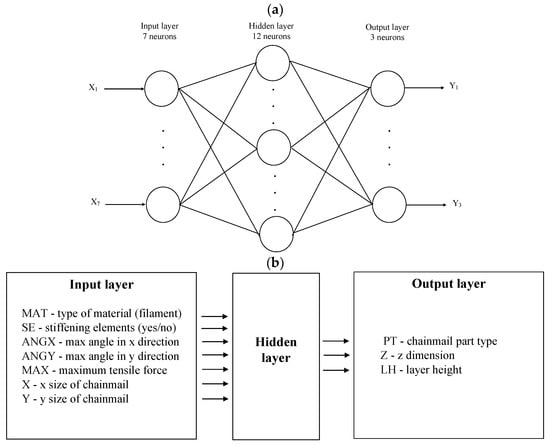
Figure 1.
Traditional ANN structure [13], (a) the general structure of the neural network, (b) inputs and outputs of the neural network. Where: MAT—type of 3D printing material (filament), SE—presence of stiffening elements in the 3D printed chainmail (yes/no), ANGX—max angle of chainmail bending in x direction, ANGY—max angle of chainmail bending in y direction, MAX—maximum tensile force, X—size of chainmail in x direction, Y—size of chainmail in y direction, PT—chainmail part type, Z—chainmail part height, LH—3D printing layer height.
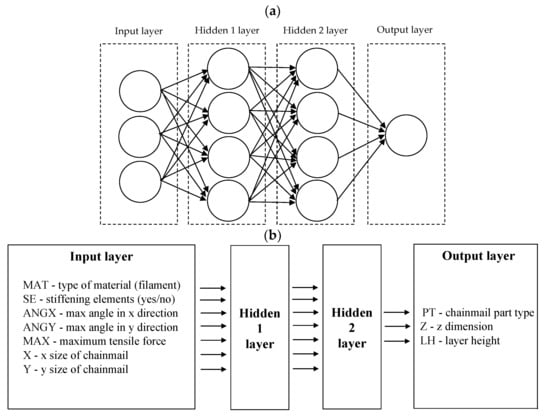
Figure 2.
CNN structure: (a) general rule, (b) inputs and outputs.
The initial dataset consisted of much more parameters (60 parameters taken from the printer and slicer software—e.g., layer height or seam position, whole list of this parameters is presented in [13]), but it only increased computational effort without significantly affecting the accuracy of the final result.
The change in MSE for the two aforementioned neural network structures is shown in Figure 3.
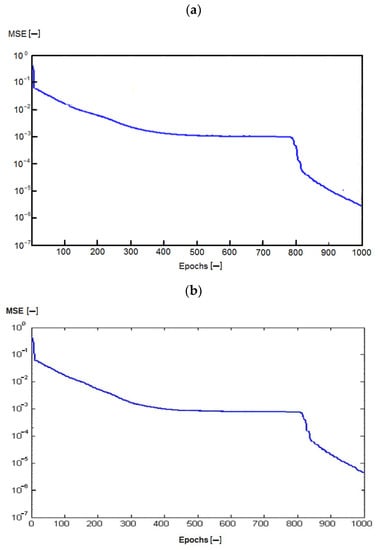
Figure 3.
Values of MSE during learning for: (a) ANN [13], (b) CNN.
Layers of the network contained neurons with the particular activation functions (Table 1).

Table 1.
ANN [13] vs CNN network model.
Table 2, Table 3, Table 4 and Table 5 show the best CNN solutions to solve the task compared to previous AAN solution [13] in the area of quality assessment and MSE. Performance of the DL is much better.

Table 2.
Selected ANNs quality assessment.

Table 3.
Selected CNNs quality assessment.

Table 4.
(R) MSE values for used ANNs.

Table 5.
(R) MSE values for used CNNs.
3. Results
In the study, DL not only allowed the network to speed up, increase accuracy and reduce MSE, but also—as an effect—allowed the realization of 3D prints such as those shown below (Figure 4). This was made possible by better optimization of parameters using DL. A single chainmail’s element in the study consists of:
- Base—an element that is placed on the table during 3D printing (marked in red);
- Dyelet—a part connecting individual elements (marked in blue).
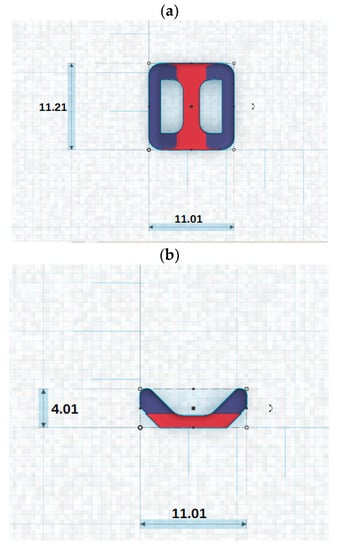
Figure 4.
Construction of a single element with basic (minimal) stiffness: (a) top view, (b) side view.
With DL, we can improve and optimize the stiffness of the chainmail with a stiffening element (Figure 5). Adjustment is made by setting the height and width of the stiffening element. The higher and wider the element, the more rigid it becomes.
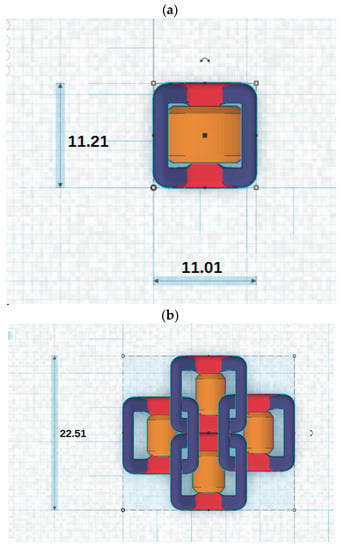
Figure 5.
Construction of a single element-stiffness adjustment by means of a stiffening element (orange): (a) one element, (b) multiple elements.
Changing the stiffness of the chainmail by changing the size of the stiffening element is shown in Figure 6. The aforementioned adaptation, especially individual adaptation, is only possible through the use of DL, as a great many internal design variables have to be taken into account to achieve such effects in 3D printing.

Figure 6.
Stiffness adjustment by means setting the height and width of the stiffening element.
By using CNN to generate supports (overflows), the same effect can be achieved, but much faster. We then manipulate the stiffness of the material by adjusting the following parameters:
- The spacing of the pattern (the spacing of the lines between the supports): the smaller spacing means the stiffer material;
- Z spacing (perpendicular to the movement of the table and the force of gravity), i.e., the vertical distance between the individual layers of the support (stiffener) and the actual model: the smaller spacing for the individual layers means the stiffer material;
- the pattern/shape of the support (stiffener).
Individual pieces are assembled into chainmail. Detailed chainmail designed by DL is shown in Figure 7. Its exactness is far beyond possibilities of traditional ANN.
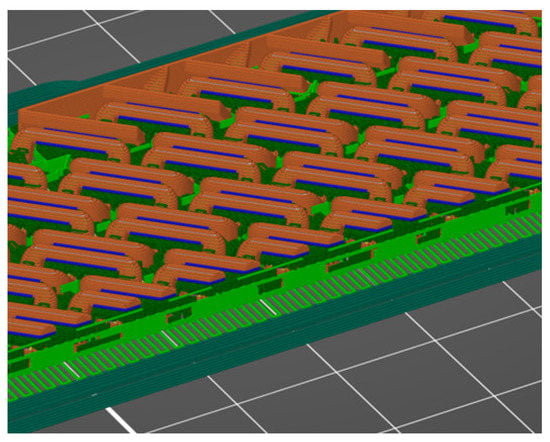
Figure 7.
Chainmail designed by DL.
A raft generation algorithm was used as a stiffening material. It is a material that allows the fabric to “breathe” (ideally to move air and water) while at the same time being easily and very well stiffened. We manipulated the stiffness of the fabric through parameters:
- Number of raft layers: more elements mean stiffer chainmail;
- The spacing of the pattern, i.e., the spacing of the lines between the lines: the smaller the spacing the stiffer material;
- Z-axis distance (perpendicular to table movement and gravity), i.e., the vertical distance between the individual layers of the raft: the smaller spacing between each layer means the stiffer material;
- Spacing of the elements in the raft: closer elements mean the stiffer chainmail (Figure 8).
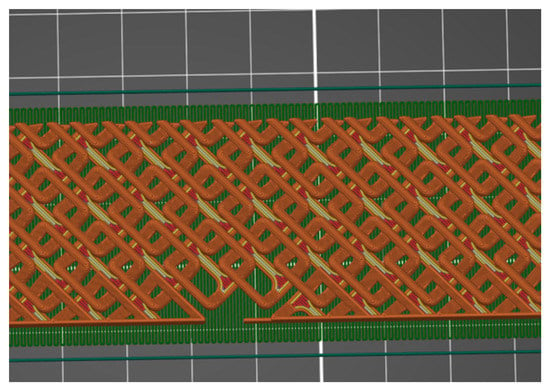 Figure 8. First layer of rafts.
Figure 8. First layer of rafts. - Such complicated multilayered shapes can be designed only by DL.
4. Discussion
We achieved an automated or semi-automated efficient and practical design of a 3D printed chainmail with pre-programmed directional functions for a hand exoskeleton with variable stiffness/flexibility depending on direction. So far, this approach is unique. The proposed DL system, based on a set of specific parameters regarding material, layer, bending angles and dimensions in both directions and maximum tensile force, is able to propose a 3D printed chainmail solution meeting the above criteria. From the point of view of the engineer or technologist, this considerably simplifies and speeds up the design process, especially with regard to the personalization of the solution. The higher complexity of the DL network here results in improved accuracy and lower MSE, making the presented solution promising for further, even more complex projects. In the application presented in the article, the DL model enables the identification of patterns in complex biomedical data used to design exoskeletons, and on this basis it supports design and optimization at every stage of production. In a broader context, the above-mentioned approach provides support in the search for effective but non-obvious engineering solutions despite shorter design time and its lower cost due to a smaller number of design iterations. This results in faster availability of personalized solutions, having no equivalent in the literature. This paves the way for a wider implementation of adaptive chainmails based on machine learning, which is more efficient for more complex chainmail designs.
The large amount of data in the process of designing and printing 3D chainmails and the lack of complete organization of the aforementioned data in the form of databases make it difficult to analyze and use without computers. For the aforementioned reasons, the optimization and objectification of the parameter selection process using DL is a very important and future-oriented area of research.
The limitations of our research concern both the material issues, but also the connection of materials, their physicochemical properties, form and functions of printed objects with different textures and surface hardness [29].
The main limitation of the study is that it is presented in this paper for only one model. This is due to the specificity of personalized therapy, that each case is slightly different. For the aforementioned reasons, mass production of personalized rehabilitation supplies (in our case: a hand exoskeleton with printed chainmail) is only possible through the use of the Industry 4.0 paradigm, artificial intelligence and 3D printing. However, further research is needed for the proposed methodology to enter everyday clinical use. Of course, as part of our own research, we are developing the manufacture of hand exoskeletons and chainmails for various cases of hand deficits.
Recent advances in the achievement of 3D printing of chainmail for biomedical purposes are discussed in [30,31,32,33], incl. in the field of creating a lightweight, 4D-printed activation fabric. activation with heat (of the body, environment), light, humidity, pH level, or the flow of electric current and the influence of a magnetic field [32,33]. New material properties will facilitate personalized design in precision medicine or preventive medicine [34]. Hybrid Artificial Intelligence System will help in cases of Constraint Satisfaction [35,36].
5. Conclusions
By automating the production of chainmail with specific stiffness parameters, we have shown that new DL-based computational tools support engineers and can significantly improve the efficiency of designing personalized medical solutions. We have shown methodological correctness and the effectiveness of our approach. Thinking about the further development and future application of the proposed solution once we have brought our exoskeleton prototype to production, we plan to design a family of chainmail products targeting the medical consumer (including after expansion with new structural and material properties, including antibacterial). This will allow us to better target and monitor further research, and allow manufacturers to respond more quickly to gaps in the market related to, for example, the wider introduction of precision medicine or preventive medicine. In a broader context, our study shows that relying on data downloaded automatically from industrial software, artificial intelligence (including deep) analysis and prediction of trends and forecasting long-term changes may enable the implementation of innovative/modified production and therapeutic processes.
Author Contributions
Conceptualization, I.R., D.M., J.K. and E.D.; methodology, I.R., D.M., J.K., P.K., J.D. and E.D.; software, J.K. and D.M.; validation, I.R., D.M., J.K., P.K., J.D. and E.D.; formal analysis, I.R., D.M., J.K., P.K. and E.D.; investigation, I.R., D.M., J.K., P.K. and E.D.; resources, I.R., D.M. and J.K.; data curation, I.R., D.M., J.K., P.K. and E.D.; writing—original draft preparation, I.R., D.M., J.K., P.K., J.D. and E.D.; writing—review and editing, I.R., D.M., J.K., P.K., J.D. and E.D.; visualization, I.R., D.M., J.K., P.K., J.D. and E.D.; supervision, I.R., D.M. and E.D.; project administration, I.R.; funding acquisition, I.R., D.M. and E.D. All authors have read and agreed to the published version of the manuscript.
Funding
This work was supported in part by the grant to maintain research potential of Kazimierz Wielki University and grant no. 0613/SBAD/4710.
Institutional Review Board Statement
Not applicable.
Informed Consent Statement
Not applicable.
Data Availability Statement
Not applicable.
Conflicts of Interest
The authors declare no conflict of interest.
Abbreviations
| ANN | artificial neural network |
| DL | deep learning |
| IaaS | Infrastructure as a Service |
| IT | information technology |
| MDR | Medical Devices Regulation |
| MSE | mean squared error |
| PaaS | Platform as a Service |
| SaaS | Software as a Service |
References
- Majid, M.; Habib, S.; Javed, A.R.; Rizwan, M.; Srivastava, G.; Gadekallu, T.R.; Lin, J.C. Applications of Wireless Sensor Networks and Internet of Things Frameworks in the Industry Revolution 4.0: A Systematic Literature Review. Sensors 2022, 22, 2087. [Google Scholar] [CrossRef]
- Webert, H.; Döß, T.; Kaupp, L.; Simons, S. Fault Handling in Industry 4.0: Definition, Process and Applications. Sensors 2022, 22, 2205. [Google Scholar] [CrossRef]
- Osterrieder, P.; Budde, L.; Friedli, T. The smart factory as a key construct of Industry 4.0: A systematic literature review. Int. J. Prod. Econ. 2020, 221, 107476. [Google Scholar] [CrossRef]
- Nagashima, M.; Cho, S.G.; Ding, M.; Garcia Ricardez, G.A.; Takamatsu, J.; Ogasawara, T. Prediction of Plantar Forces During Gait Using Wearable Sensors and Deep Neural Networks. IEEE 2019, 2019, 3629–3632. [Google Scholar] [CrossRef]
- Hamid, H.; Naseer, N.; Nazeer, H.; Khan, M.J.; Khan, R.A.; Shahbaz Khan, U. Analyzing Classification Performance of fNIRS-BCI for Gait Rehabilitation Using Deep Neural Networks. Sensors 2022, 22, 1932. [Google Scholar] [CrossRef]
- Markiewicz, R.; Masiak, J. Evaluation of cognitive deficits in schizophrenia using event-related potentials and rehabilitation influences using EEG biofeedback in patients diagnosed with schizophrenia. Psychiatr. Pol. 2019, 53, 1261–1273. [Google Scholar] [CrossRef]
- Wojcik, G.M.; Masiak, J.; Kawiak, A.; Kwasniewicz, L.; Schneider, P.; Postepski, F.; Gajos-Balinska, A. Analysis of decision-making process using methods of quantitative electroencephalography and machine learning tools. Front. Neuroinform. 2019, 13, 73. [Google Scholar] [CrossRef]
- Awad, A.; Trenfield, S.J.; Pollard, T.D.; Ong, J.J.; Elbadawi, M.; McCoubrey, L.E.; Goyanes, A.; Gaisford, S.; Basit, A.W. Connected healthcare: Improving patient care using digital health technologies. Adv. Drug Deliv. Rev. 2021, 178, 113958. [Google Scholar] [CrossRef]
- Regulation (Eu) 2017/745 of the European Parliament and of the Council of 5 April 2017 on Medical Devices, Amending Directive 2001/83/EC, Regulation (EC) No 178/2002 and Regulation (EC) No. 1223/2009 and Repealing Council Directives 90/385/EEC and 93/42/EEC. Available online: https://eur-lex.europa.eu/legal-content/EN/TXT/PDF/?uri=CELEX:32017R0745 (accessed on 30 June 2022).
- ISO 13485:2016 Medical Devices Quality Management Systems. Available online: https://www.iso.org/obp/ui#iso:std:iso:13485:ed-3:v1:en (accessed on 30 June 2022).
- Elbadawi, M.; McCoubrey, L.E.; Gavins, F.K.H.; Ong, J.J.; Goyanes, A.; Gaisford, S.; Basit, A.W. Disrupting 3D printing of medicines with machine learning. Trends Pharmacol. Sci. 2021, 42, 745–757. [Google Scholar] [CrossRef]
- Bustos, A.; Rubio, H.; Soriano-Heras, E.; Castejon, C. Methodology for the integration of a high-speed train in Maintenance 4.0. J. Comput. Des. Eng. 2021, 8, 1605–1621. [Google Scholar] [CrossRef]
- Kopowski, J.; Mikołajewski, D.; Kotlarz, P.; Dostatni, E.; Rojek, I. A Semi-Automated 3D-Printed Chainmail Design Algorithm with Preprogrammed Directional Functions for Hand Exoskeleton. Appl. Sci. 2022, 12, 5007. [Google Scholar] [CrossRef]
- Rojek, I.; Mikołajewski, D.; Dostatni, E.; Macko, M. AI-Optimized Technological Aspects of the Material Used in 3D Printing Processes for Selected Medical Applications. Materials 2020, 13, 5437. [Google Scholar] [CrossRef]
- Rojek, I.; Mikołajewski, D.; Dostatni, E. Digital Twins in Product Lifecycle for Sustainability in Manufacturing and Maintenance. Appl. Sci. 2021, 11, 31. [Google Scholar] [CrossRef]
- Kopowski, J.; Mikołajewski, D.; Macko, M.; Rojek, I. Bydgostian hand exoskeleton-own concept and the biomedical factors. Bio-Algorithms Med.-Syst. 2019, 15, 20190003. [Google Scholar] [CrossRef]
- Ransley, M.; Smitham, P.; Miodownik, M. Active chainmail fabrics for soft robotic applications. Smart Mater. Struct. 2017, 26, 08LT02. [Google Scholar] [CrossRef]
- Cabibihan, J.J.; Alkhatib, F.; Mudassir, M.; Lambert, L.A.; Al-Kwifi, O.S.; Diab, K.; Mahdi, E. Suitability of the Openly Accessible 3D Printed Prosthetic Hands for War-Wounded Children. Front. Robot. AI 2021, 7, 594196. [Google Scholar] [CrossRef]
- Pace, D.F.; Dalca, A.V.; Brosch, T.; Geva, T.; Powell, A.J.; Weese, J.; Moghari, M.H.; Golland, P. Iterative Segmentation from Limited Training Data: Applications to Congenital Heart Disease. In Deep Learning in Medical Image Analysis and Multimodal Learning for Clinical Decision Support; Springer: Cham, Switzerland, 2018; Volume 11045, pp. 334–342. [Google Scholar] [CrossRef]
- Pace, D.F.; Dalca, A.V.; Brosch, T.; Geva, T.; Powell, A.J.; Weese, J.; Moghari, M.H.; Golland, P. Learned iterative segmentation of highly variable anatomy from limited data: Applications to whole heart segmentation for congenital heart disease. Med. Image Anal. 2022, 80, 102469. [Google Scholar] [CrossRef]
- Taylor, J.M.; Luan, H.; Lewis, J.A.; Rogers, J.A.; Nuzzo, R.G.; Braun, P.V. Biomimetic and Biologically Compliant Soft Architectures via 3D and 4D Assembly Methods: A Perspective. Adv. Mater. 2022, 34, 2108391. [Google Scholar] [CrossRef]
- Zhang, J.; Yin, Z.; Ren, L.; Liu, Q.; Ren, L.; Yang, X.; Zhou, X. Advances in 4D Printed Shape Memory Polymers: From 3D Printing, Smart Excitation, and Response to Applications. Adv. Mater. Technol. 2022, 210156. [Google Scholar] [CrossRef]
- Bean, P.; Lopez-Anido, R.A.; Vel, S. Numerical Modeling and Experimental Investigation of Effective Elastic Properties of the 3D Printed Gyroid Infill. Appl. Sci. 2022, 12, 2180. [Google Scholar] [CrossRef]
- Volk, M.J.; Lourentzou, I.; Mishra, S.; Vo, L.T.; Zhai, C.; Zhao, H. Biosystems Design by Machine Learning. ACS Synth. Biol. 2020, 9, 1514–1533. [Google Scholar] [CrossRef]
- Dudley, D.R.; Knarr, B.A.; Siu, K.C.; Peck, J.; Ricks, B.; Zuniga, J.M. Testing of a 3D printed hand exoskeleton for an individual with stroke: A case study. Disabil. Rehabil. Assist. Technol. 2021, 16, 209–213. [Google Scholar] [CrossRef]
- Mishra, C.; Gupta, D. Deep Machine Learning and Neural Networks: An Overview. IAES Int. J. Artif. Intell. 2017, 6, 66. [Google Scholar] [CrossRef]
- Walsh, J.; O’ Mahony, N.; Campbell, S.; Carvalho, A.; Krpalkova, L.; Velasco-Hernandez, G.; Harapanahalli, S.; Riordan, D. Deep Learning vs. Traditional Computer Vision; Springer: Cham, Switzerland, 2019. [Google Scholar] [CrossRef]
- Nash, W.; Drummond, T.; Birbilis, N. A Review of Deep Learning in the Study of Materials Degradation. NPJ Mater. Degrad. 2018, 2, 37. [Google Scholar] [CrossRef]
- Rojek, I.; Kowal, M.; Stoic, A. Predictive compensation of thermal deformations of ball screws in cnc machines using neural networks. Teh.-Tech. Gaz. 2017, 24, 1697–1703. [Google Scholar] [CrossRef]
- Machrowska, A.; Szabelski, J.; Karpiński, R.; Krakowski, P.; Jonak, J.; Jonak, K. Use of Deep Learning Networks and Statistical Modeling to Predict Changes in Mechanical Parameters of Contaminated Bone Cements. Materials 2020, 13, 5419. [Google Scholar] [CrossRef]
- Liu, Y.; Yuan, Y.; Balta, C.; Liu, J. A Light-Weight Deep-Learning Model with Multi-Scale Features for Steel Surface Defect Classification. Materials 2020, 13, 4629. [Google Scholar] [CrossRef]
- Nunez, I.; Marani, A.; Nehdi, M.L. Mixture Optimization of Recycled Aggregate Concrete Using Hybrid Machine Learning Model. Materials 2020, 13, 4331. [Google Scholar] [CrossRef]
- Zazoum, B.; Triki, E.; Bachri, A. Modeling of Mechanical Properties of Clay-Reinforced Polymer Nanocomposites Using Deep Neural Network. Materials 2020, 13, 4266. [Google Scholar] [CrossRef]
- Rojek, I. Neural networks as performance improvement models in intelligent CAPP systems. Control. Cybern. 2010, 39, 55–68. [Google Scholar]
- Rojek, I.; Jagodziński, M. Hybrid Artificial Intelligence System in Constraint Based Scheduling of Integrated Manufacturing ERP Systems. In 7th International Conference on Hybrid Artificial Intelligent Systems (HAIS); Springer: Berlin/Heidelberg, Germany, 2012; Volume 7209, pp. 229–240. [Google Scholar]
- Rojek, I. Models for Better Environmental Intelligent Management within Water Supply Systems. Water Resour. Manag. 2014, 28, 3875–3890. [Google Scholar] [CrossRef]
Publisher’s Note: MDPI stays neutral with regard to jurisdictional claims in published maps and institutional affiliations. |
© 2022 by the authors. Licensee MDPI, Basel, Switzerland. This article is an open access article distributed under the terms and conditions of the Creative Commons Attribution (CC BY) license (https://creativecommons.org/licenses/by/4.0/).